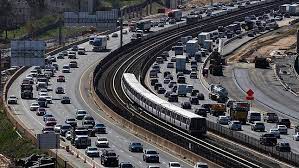By: Brett Samuels and Jonathan Easley, The Hill
President Biden will unveil an ambitious infrastructure package Wednesday in Pittsburgh as he outlines his next big legislative push.
The president will travel to the same city where he announced his White House candidacy in 2019 to promote what is expected to be a multitrillion-dollar proposal. He’s also expected to provide specifics about a proposal that’s likely to go well beyond funding for roads and bridges.
Here are five things to watch when Biden shares details of his plan.
What’s the price tag?
The final price tag for Biden’s infrastructure-focused proposal is expected to total roughly $2 trillion over eight years, though White House officials have made clear they will work with Congress on the final product.
The top-line number will be key to getting moderate Democrats and even some Republicans engaged from the start, as a sky-high dollar amount would likely turn off centrists worried about adding to the federal debt.
But that’s not stopping progressive lawmakers and outside groups from urging Biden to go even bigger with his Build Back Better agenda.
Americans for Tax Fairness, a left-leaning advocacy group, estimated that if Biden followed through on his campaign pledges on infrastructure and climate, Wednesday’s proposal would total nearly $7 trillion over the next decade.
The Sunrise Movement, a liberal group focused on climate issues, said in a release Tuesday that the Biden administration should commit to spending a minimum of $1 trillion a year over the next decade on green jobs and the climate crisis.
“It is clear that if Biden is serious about transforming our economy and building back better, a much greater scale of investment is needed,” the organization said.
How will Biden pay for it?
The White House has been adamant that Biden will lay out how to pay for his infrastructure proposal in its entirety. But doing so will mean tax increases, where Biden may find a hard time reaching consensus with lawmakers, both Republicans and moderate Democrats.
“He believes that there’s more that can be done to make the corporate tax code fair, to reward work not wealth, to ensure that we can invest in the future industries that are going to help all people in this country,” White House press secretary Jen Psaki said Tuesday.
Psaki has insisted that the administration will work with members of Congress on both sides of the aisle to find agreement on how to pay for the package.
The White House has signaled it will propose increasing the corporate tax to 28 percent after it was lowered from 35 percent to 21 percent during the Trump administration.
A senior administration official said changes to the corporate tax code would pay for Biden’s proposal in full over a 15 year period.
The debate over how to pay for the proposal is likely to suck up much of the oxygen on Capitol Hill once Biden outlines his plan. Moderate Democrats want to see caps on the state and local tax deduction lifted, progressives want to focus tax hikes for the wealthy and Republicans are likely to balk at any changes that result in new or higher taxes.
What is the mix of traditional infrastructure vs. other priorities?
Part of the uncertainty around Biden’s announcement on Wednesday revolves around what he will propose after the White House made clear it will split physical and human infrastructure components into two parts.
The first package is likely to focus on roads, railways and bridges, as well as broadband access around the country. Much of the proposal is also likely to be dedicated to clean energy and climate-friendly projects that reduce emissions and seek to combat the climate crisis.
The proposal, which is branded “The American Jobs Plan,” contains four parts broken up into transportation infrastructure, modern infrastructure like broadband, investing in the care economy to aid health workers and funding innovation and research and development infrastructure.
Biden’s allies are pushing him to focus on climate in particular, viewing it as a pivotal moment to take bold action with or without Republicans.
“We can’t wait for Republicans to have some awakening on climate change here; we’d be waiting forever for that. We’ve got a window to get this done,” Rep. Pramila Jayapal (D-Wash.), the chairwoman of the Congressional Progressive Caucus, said on a call with reporters.
A second package focusing on the human component, to be unveiled in April, will likely include proposals on child care and health care programs.
Will Biden signal he’s willing to bypass Republicans?
Democrats face a dilemma in deciding whether to use the arcane budget reconciliation process to get around a potential GOP filibuster in the Senate.
The reconciliation process would potentially allow Democrats to push through another huge spending bill without any Republican support, as happened with the American Rescue Plan earlier this year.
Biden campaigned on uniting a divided country and he’s promised to try to find areas of agreement or compromise where he can work with Republicans. He would love to be able to hang a bipartisan accomplishment on his mantel to take back to voters as a promise kept.
At the same time, Biden’s window for achieving big legislative victories is quite narrow.
The president is enjoying an extended honeymoon period with high job approval numbers, but popularity is fleeting and Biden used some of his political capital on the $1.9 trillion COVID-19 relief bill. As the 2022 midterm elections draw closer, the politics will grow more frenzied and legislation will become even more difficult to pass. In a 50-50 Senate, Biden has to worry as much about losing one Democrat as he does about convincing Republicans to work with him.
There will be pressure from Democrats to go it alone at the first sign of GOP resistance, as the party feels an urgency to take advantage of their full control in Washington.
Sen. Chris Coons (D-Del.), who is close with Biden, has talked about moving the infrastructure bills in smaller pieces, hoping to gain Republican support for uncontroversial measures in a smaller package before moving on to the ambitious pieces Democrats hope to include on climate change and expanding access to health care and education.
Can Biden get moderate Democrats on board?
With a razor-thin Democratic majority in the House and a 50-50 split in the Senate, moderate Democrats will have outsized influence over the fate of the infrastructure bill.
Biden can’t afford to lose even one Democrat in the Senate to get the bill across if they go the reconciliation route, which requires a simple majority for passage.
That means the swing Democrats, led by Sens. Joe Manchin (W.Va.) and Kyrsten Sinema (Ariz.), will have a big say in how ambitious the infrastructure package is and whether it passes through regular order or the budget reconciliation process.
Manchin has already said he won’t support a bill unless there is a real effort to reach out to Republicans, although he left himself some wiggle room if he feels Republicans are unreasonably standing in the way.
The number of independent-minded members in the Senate expands beyond Manchin and Sinema, to Sens. Tom Carper (D-Del.), Mark Kelly (D-Ariz.), Jeanne Shaheen (D-N.H.), Maggie Hassan (D-N.H.), Gary Peters (D-Mich.), Debbie Stabenow (D-Mich.), Jon Tester (D-Mont.) and Angus King (I-Maine), some of whom used their influence in the new Congress to push for changes in the COVID-19 relief bill.
The politics in the House is just as precarious, with Democrats only holding an eight-seat majority. A bill that is too big could turn off moderates facing tough reelection fights in swing districts.







